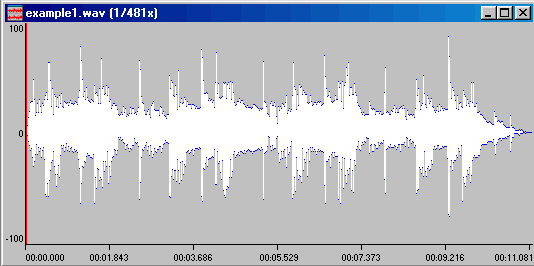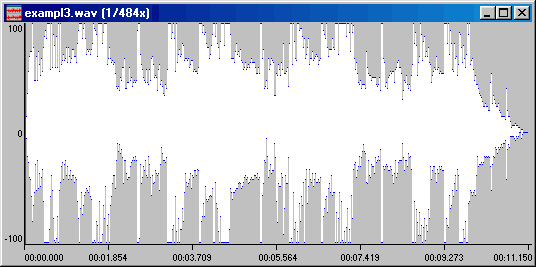How to Prevent Distortion
Unwanted distortion is caused by a signal which is "too strong". If an audio signal level is too high for a particular component to cope with, then parts of the signal will be lost. This results in the rasping distorted sound.
To illustrate this point, the pictures below represent a few seconds of music which has been recorded by a digital audio program. The maximum possible dynamic range (the range from quietest to loudest parts) of the signal is shown as 0 to +/-100 units

In the first example, the amplitude (strength / height) of the signal falls comfortably within the +/-100 unit range. This is a well-recorded signal.

In the second example, the signal is amplified by 250%. In this case, the recording components can no longer accommodate the dynamic range, and the strongest portions of the signal are cut off. This is where distortion occurs.
These examples can be used as an analogy for any audio signal. Imagine that the windows above represent a pathway through a component in a sound system, and the waves represent the signal travelling along the pathway. Once the component's maximum dynamic range is breached, you have distortion.
Minimising Distortion
Distortion can occur at almost any point in the audio pathway, from the microphone to the speaker. The first priority is to find out
exactly where the problem is.
Ideally, you would want to measure the signal level at as many points as possible, using a VU (Volume Unit) meter or similar device. Generally speaking, you should keep the level below about 0dBu at every point in the pathway.
If you can't measure the signal level, you'll have to do some deducing. Follow the entire audio pathway, beginning at the source (the source could be a microphone, tape deck, musical instrument, etc). Here are some things to look for:
- Is the distortion coming from a microphone? This could be caused by a very loud noise being too close to the mic. Try moving the mic further away from the noise source.
- Are you seeing any "peak" or "clip" lights on any of your equipment? These are warnings that a signal level is too high.
- Are any volume or gain controls in your system turned up suspiciously high? Are there any obvious points where you could drop the level?
- Are your speakers being driven too hard? If you have an amplifier which is pushing the speakers beyond their design limits, then be careful - you may well find that the distortion becomes permanent.
- If the distortion is coming from occasional peaking, consider adding a compressor.
- Could the distortion be caused by faultyequipment?
- Is the problem really distortion? There are some other unpleasant noises which could be confused with distortion; for example, the graunching sounds made by a dodgy cable connection or dirty volume knob.